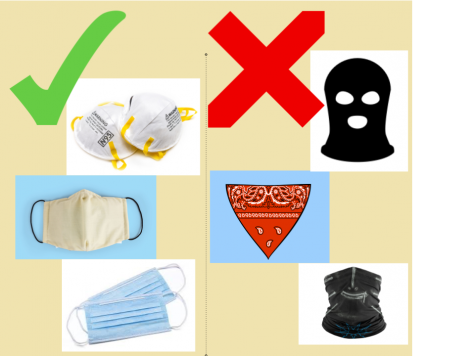A Guide to Masks
February 23, 2021
As we leave to step out of our homes, we grab our keys, wallets, bags, maybe a coat and the (hopefully) unforgettable mask. Almost a year has passed since the coronavirus pandemic swept over the world, and masks have become a daily necessity that is imperative to stopping the spread of the virus.
According to the Centers for Disease Control and Prevention (CDC), everyone over the age of two is advised to wear a mask in any public setting. As referred to on the CDC website, investigations across the globe have proven the effectiveness of masking on limiting the spread of infection. However, masking is only effective when done correctly and universally.
Masks should fit snugly over the nose, against the sides of one’s face and under the chin. Often, people’s masks slide below their nose, covering only their mouths. This is ineffective. Inhalation and exhalation through the nose will not be protected by the mask, and germs will therefore spread rapidly. Disposable masks should be thrown away after single use, and reusable masks should be laundered whenever it gets dirty, which translates to daily.
The use of masks goes both ways– it protects the wearer and the bystander. For masks to work, everyone must wear them. In an interaction between a masked individual named John and an unmasked individual named Tom, Tom is protected since John’s germs are contained by a mask, but John is at risk because even though he is wearing a mask, Tom’s germs are released into the air. Everyone has to wear masks for full efficiency.

So, which masks are acceptable, and which are not?
The foremost recommended option for day-to-day use is a cotton or cloth mask with two layers minimum. These can easily be made at home or purchased in many stores. Cloth masks with one layer, however, are not adequate as they do not fully block germs and particles. Additionally, disposable and non-surgical masks can be used as acceptable forms of masking, but they should be discarded after every use. Finally, the medically approved N-95 masks are acceptable and efficient options. However, it is recommended that we refrain from using these masks and rather reserve them for the medical professionals who need but are currently in a shortage of them.
To err on the safe side of this pandemic, it is best to assume that other forms of coverage are not acceptable. Neck gaiters, ski masks, scarves, masks with vents and masks made of permeable materials such as silk or knit are all forms of inadequate protection and should be avoided.
Most recently, with the threat of new COVID variants circulating, the CDC and Dr. Anthony Fauci, the director of National Institute of Allergy and Infectious Disease (NIAID) and White House chief medical officer, recommended the adoption of double masking– wearing two masks for better protection. The best combination seems to be a 3-ply surgical mask under a double or triple layer cloth mask. Together, these masks are nearly as effective as the N-95 and offer extra filtration, as well as an improved fit.
Ultimately, masking seems to be our best bet in reducing the spread of COVID and nearing its end, and evidence suggests that it is also an effective one. It is important, then, that everyone work to fulfill their social responsibility and wear a mask (correctly).


